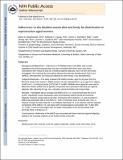| dc.contributor.author | Boghossian, Nansi S. | en_US |
| dc.contributor.author | Yeung, Edwina H. | en_US |
| dc.contributor.author | Mumford, Sunni L. | en_US |
| dc.contributor.author | Zhang, Cuilin | en_US |
| dc.contributor.author | Gaskins, Audrey J. | en_US |
| dc.contributor.author | Wactawski-Wende, Jean | en_US |
| dc.contributor.author | Schisterman, Enrique F. | en_US |
| dc.date.accessioned | 2014-03-10T16:16:04Z | |
| dc.date.issued | 2013 | en_US |
| dc.identifier.citation | Boghossian, Nansi S., Edwina H. Yeung, Sunni L. Mumford, Cuilin Zhang, Audrey J. Gaskins, Jean Wactawski-Wende, and Enrique F. Schisterman. 2013. “Adherence to the Mediterranean diet and body fat distribution in reproductive aged women.” European journal of clinical nutrition 67 (3): 289-294. doi:10.1038/ejcn.2013.4. http://dx.doi.org/10.1038/ejcn.2013.4. | en |
| dc.identifier.issn | 0954-3007 | en |
| dc.identifier.uri | http://nrs.harvard.edu/urn-3:HUL.InstRepos:11876988 | |
| dc.description.abstract | Background/Objectives Adherence to the Mediterranean Diet (MD) high in fruits, vegetables and monounsaturated fats, has been associated with lower body mass index. Associations with measured body fat, including regional adiposity, have not been previously investigated. We examined the associations between the alternate Mediterranean Diet Score (aMED), anthropometry and measured adiposity by dual energy x-ray absorptiometry. Subjects/Methods This study included 248 healthy females, aged 18–44 years from the BioCycle Study. Each woman’s aMED (range 0–9) was calculated from up to eight 24-hr dietary recalls over 1–2 menstrual cycles (>97% had ≥7 recalls). Multiple linear regression was used to determine whether aMED and its specific components were associated with total and regional adiposity after adjusting for age, race, education, physical activity and energy intake. Results: Participants had an average (SD) aMED of 4.2 (1.7) and percent body fat of 29.5 (6.0)%. Significant inverse associations were found between aMED and all the examined adiposity measures except waist to hip ratio. Among the DXA measures, a 1-unit increment in aMED was associated with a 0.06 (95% CI:−0.09,−0.02) lower trunk-to-leg fat ratio (T/L), a measure of upper to lower body fat. In an analysis examining T/L as an outcome with the separate components of the aMED, T/L was lower with increased legume consumption (β=−0.280, 95% CI:−0.550,−0.010) but was higher with increased consumption of red and processed meat (β=0.060, 95% CI:0.002,0.117). Conclusions: Adherence to the aMED was associated with lower total and regional adiposity, adding to the mounting evidence of the health benefits of the MD. | en |
| dc.language.iso | en_US | en |
| dc.relation.isversionof | doi:10.1038/ejcn.2013.4 | en |
| dc.relation.hasversion | http://www.ncbi.nlm.nih.gov/pmc/articles/PMC3594052/pdf/ | en |
| dash.license | LAA | en_US |
| dc.subject | Mediterranean Diet | en |
| dc.subject | body fat | en |
| dc.subject | trunk fat | en |
| dc.subject | regional adiposity | en |
| dc.subject | obesity | en |
| dc.subject | body mass index | en |
| dc.subject | DXA | en |
| dc.title | Adherence to the Mediterranean diet and body fat distribution in reproductive aged women | en |
| dc.type | Journal Article | en_US |
| dc.description.version | Version of Record | en |
| dc.relation.journal | European journal of clinical nutrition | en |
| dash.depositing.author | Gaskins, Audrey J. | en_US |
| dc.date.available | 2014-03-10T16:16:04Z | |
| dc.identifier.doi | 10.1038/ejcn.2013.4 | * |
| dash.contributor.affiliated | Gaskins, Audrey | |


